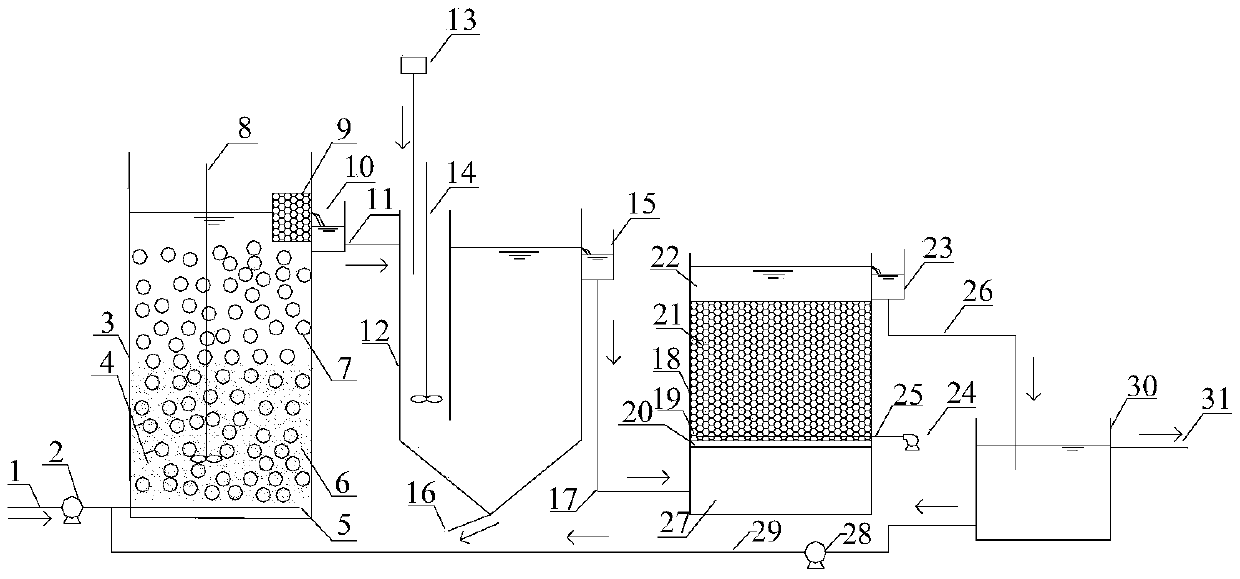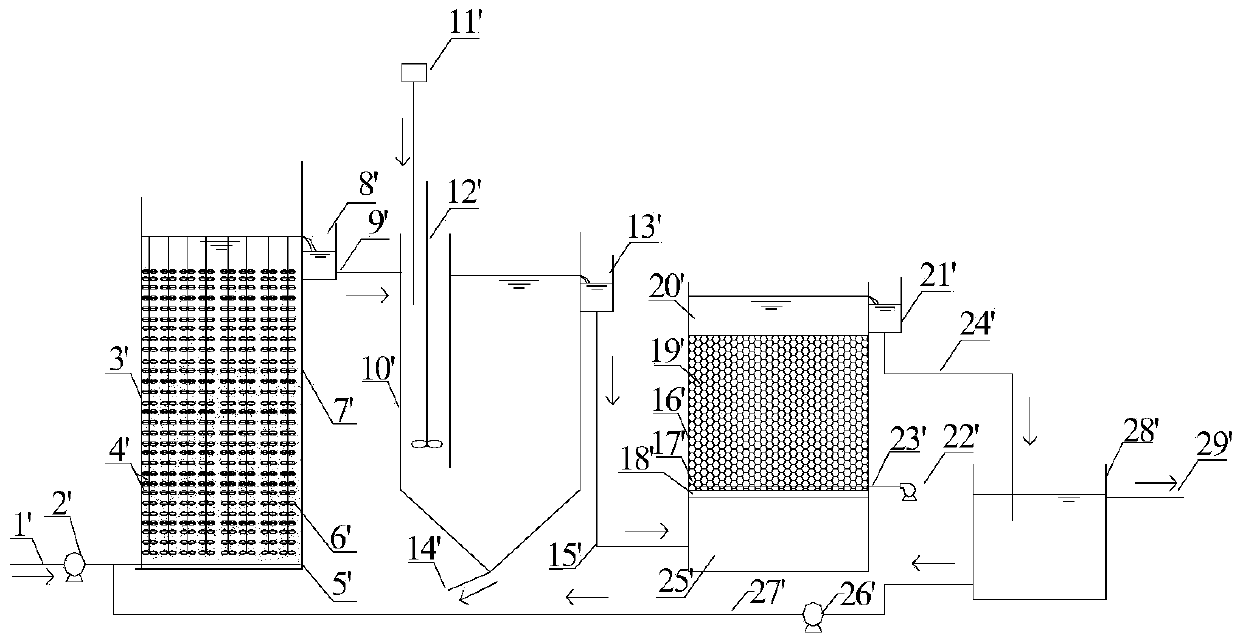Efficient nitrogen and phosphorus removal waste water treatment process and device
A sewage treatment device and a technology for denitrification and phosphorus removal, which are applied in the field of water treatment, can solve the problems of poor nitrification effect, insufficient utilization of carbon sources, and low treatment efficiency of structures, and achieve less sludge deposition, low cost, and large promotion. The effect of applying value
- Summary
- Abstract
- Description
- Claims
- Application Information
AI Technical Summary
Problems solved by technology
Method used
Image
Examples
Embodiment 1
[0024] A domestic sewage treatment plant with a treatment capacity of 10,000 m 3 / d, influent COD concentration is 240mg / L, TP12mg / L, NH 3 -N (ammonia nitrogen) concentration is 40mg / L, TN (total nitrogen) is 60mg / L, and suspended solids (SS) is 135mg / L. Sewage is treated sequentially through a flow-type membrane mud coupling tank, a chemical phosphorus removal tank, an aerobic nitrification biological filter, and a clear water tank. The hydraulic retention time of the flow-type membrane-slime coupling tank is 1h, with 4 sets of stirring devices, the carrier filling rate is 50%, and the reflux ratio of the nitrifying liquid is 100%. 1h. The final effluent meets the first-class A discharge standard in the "Pollutant Discharge Standards for Urban Sewage Treatment Plants" (GB18918-2002).
Embodiment 2
[0026] A chemical wastewater treatment plant with a treatment capacity of 3,000 m 3 / d, influent COD concentration is 2240mg / L, TP42mg / L, NH 3 -N (ammonia nitrogen) concentration is 90mg / L, TN (total nitrogen) is 600mg / L, and suspended solids (SS) is 635mg / L. Wastewater is treated sequentially through membrane mud coupling pool, chemical phosphorus removal pool, aerobic nitrification biological filter, and clear water pool. The hydraulic retention time of the membrane mud coupling tank is 10h, 5 sets of stirring devices, the carrier filling rate is 60%, the reflux ratio of the nitrification liquid is 300%; the dissolved oxygen of the aerobic nitrification biological filter is 6.0mg / L, and the hydraulic retention time is 12h. Final effluent COD concentration is 150mg / L, TP0.02mg / L, NH 3 -N (ammonia nitrogen) concentration is 2mg / L, TN (total nitrogen) is 65mg / L, and suspended solids (SS) is 8mg / L.
Embodiment 3
[0028] A domestic sewage treatment plant with a treatment capacity of 10,000 m 3 / d, influent COD concentration is 240mg / L, TP12mg / L, NH 3-N (ammonia nitrogen) concentration is 40mg / L, TN (total nitrogen) is 60mg / L, and suspended solids (SS) is 135mg / L. Sewage is treated sequentially through fixed membrane-mud coupling tank, chemical phosphorus removal tank, aerobic nitrification biological filter and clear water tank. The hydraulic retention time of the fixed membrane-mud coupling tank is 2 hours, and the reflux ratio of the nitrification liquid is 150%; the dissolved oxygen of the aerobic nitrification biological filter is 4.0 mg / L, and the hydraulic retention time is 3 hours. The final effluent meets the first-class A discharge standard in the "Pollutant Discharge Standards for Urban Sewage Treatment Plants" (GB18918-2002).
PUM
 Login to View More
Login to View More Abstract
Description
Claims
Application Information
 Login to View More
Login to View More - R&D
- Intellectual Property
- Life Sciences
- Materials
- Tech Scout
- Unparalleled Data Quality
- Higher Quality Content
- 60% Fewer Hallucinations
Browse by: Latest US Patents, China's latest patents, Technical Efficacy Thesaurus, Application Domain, Technology Topic, Popular Technical Reports.
© 2025 PatSnap. All rights reserved.Legal|Privacy policy|Modern Slavery Act Transparency Statement|Sitemap|About US| Contact US: help@patsnap.com



